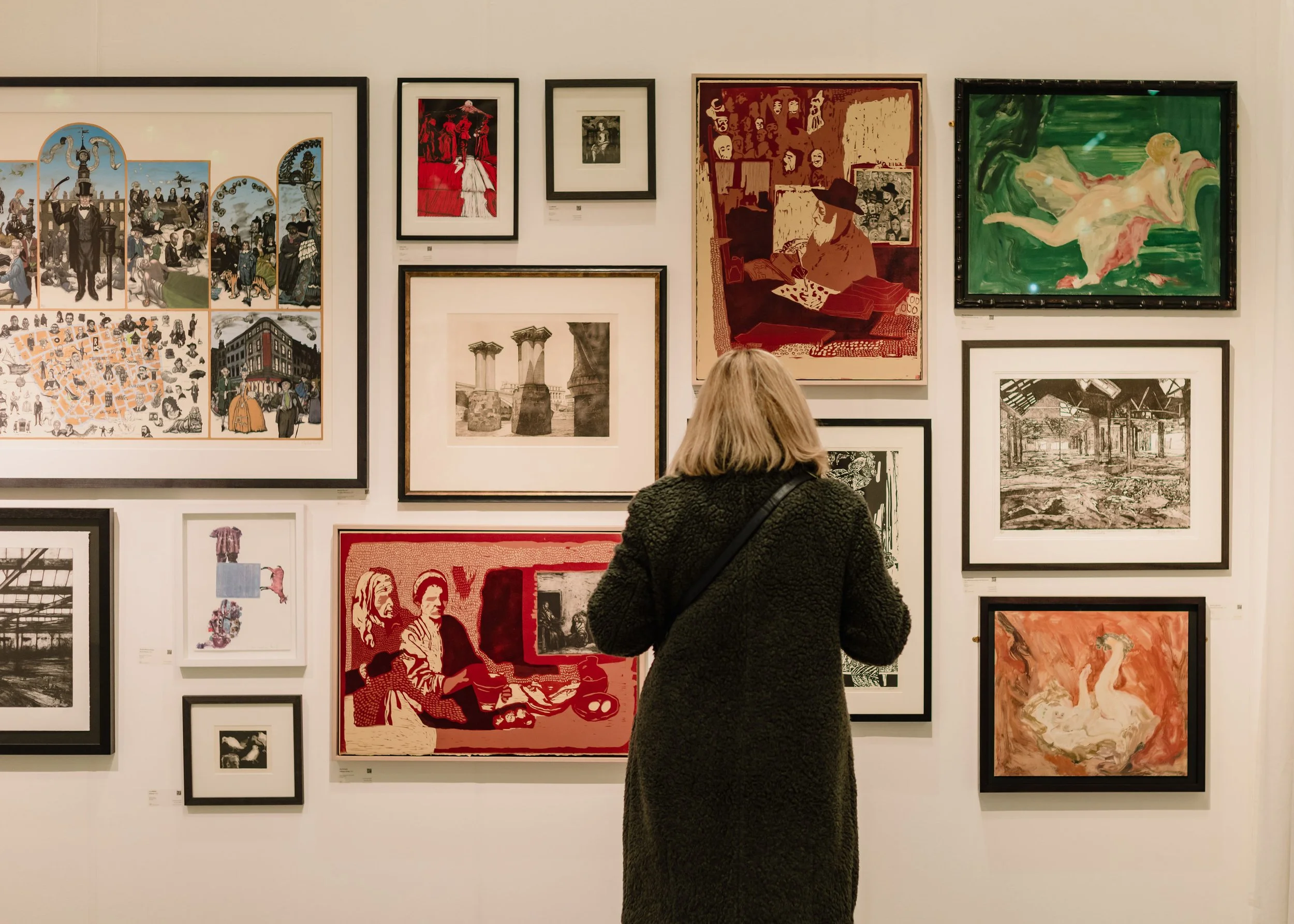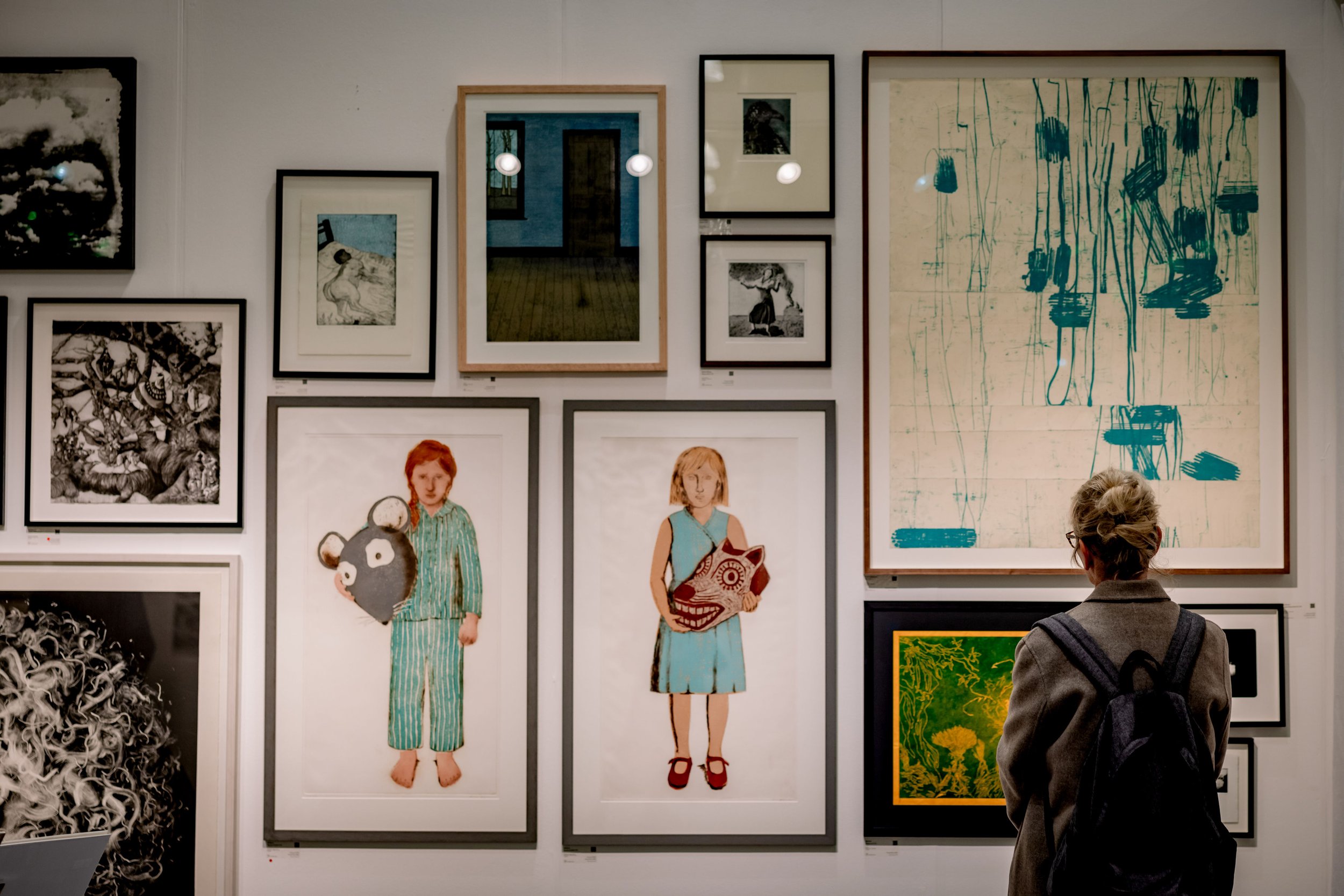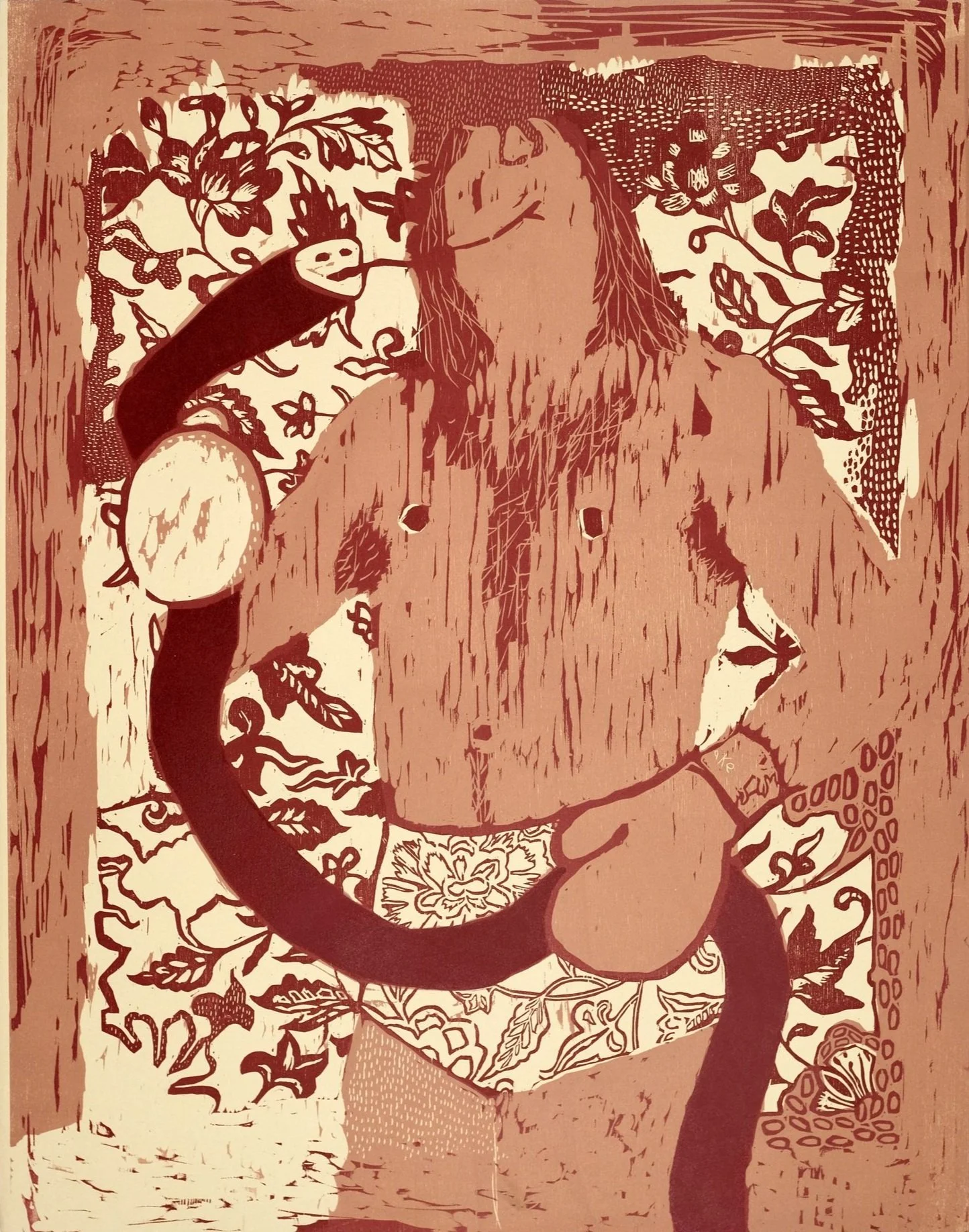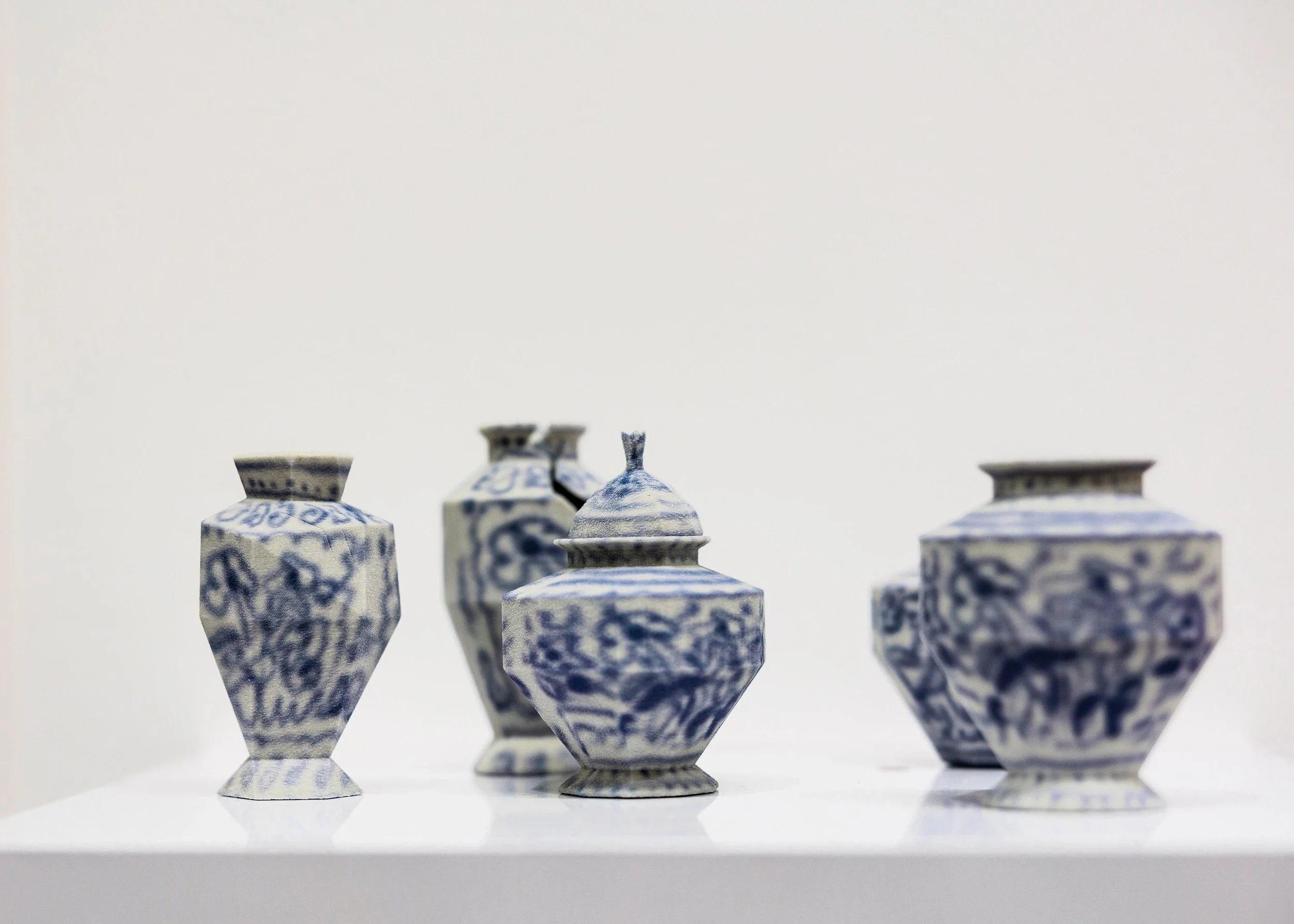
WHY PRINT?
Printmaking is a great introduction to collecting fine art. The nature of editioning (that is the creation of more than one ‘impression’) can make it a more affordable art form, than oil or watercolour for example. Moreover, the more accessible prices mean you have the flexibility to experiment with your tastes, discover artists and learn about different techniques, while building confidence as you curate your personal collection.
WCPF is the only fair to operate a unique hybrid model of 50% specialist gallery booths, bringing some of the world’s most notable contemporary artists working in print, and 50% 'Curated Hang' of independent international artists selected by a panel of industry experts. This means that collectors have have access to thousands of original artworks at multiple entry points to establish or enhance a collection, and can also discover the next 'big thing' which offers an excellent investment opportunity.
WHAT IS A PRINT?
Simply put, a print is an image that has been transferred from one surface to another.
'Printmaking' is a broad term that encapsulates a number of fine art techniques and processes, from etchings and monotype, to digital and screen printing, in which the artist makes images from a master (plate or 'device') or 'matrix'. This includes digital or photographic work where the image has been transferred either digitally from the screen to paper, or from the negative.
Although multiple editions can be created (excluding monotypes which are unique or 'mono'/1), each individual work is indeed an ‘original’ print as it has received the artist's individual attention. All WCPF prints are unique or limited edition, meaning that the artist has produced a finite number.
WHAT IS AN ORIGINAL PRINT?
We define an ‘Original Print’ as a work of art that was conceived as a print in its first instance, as opposed to a reproduction of another original work.
This means the artist has set about to create a print, whether it is an etching, mono-print, lithograph etc. rather than simply taking a photograph or scan of an existing artwork and printing out a number of ‘reproduction’ prints like a poster. The artist decides on the number of editions within the print run and number each accordingly (eg. 1/30). There is no difference in value between the first and the last print within the edition as each one is an original artwork.
Once all editions have been printed the matrix is destroyed or repurposed so no others can be made.
TYPES OF PRINT
Prints are classified according to the type of surface used to make them. These have historically been divided into three groups: Intaglio, Relief and Planographic. Each procedure is complex, frequently used in combination with another, and is in constant state of revision and refinement. Some artists have even developed their very own printmaking technique, involving all or none of these categories.
intaglio
AQUATINT | CARBORUNDUM | DRYPOINT | ENGRAVING | ETCHING | MEZZOTINT
relief
WOOD ENGRAVING | WOODCUT | LINOCUT
Planographic
LITHOGRAPH | SCREENPRINT | MONOPRINT | DIGITAL | CYANOTYPE | STENCIL
Other Clasifications
CHINE COLLE | COLLOGRAPH | PHOTOMECHANICAL | 3D PRINT |
How to Read Prints
Any specialist terminology and jargon can be confusing or off putting. In this section we will shed some light on how an artist will sign and label their work, what to look out for and what it means.
-
The first thing most people look for, after admiring the work, is for the artist's signature which will often be placed bottom right of the image in the margin between the image and the edge of the paper. This is the artist's seal of approval and what gives the work its value. Without the artist's signature to prove authenticity it could be an unsanctioned run outside the intended edition.
Some artists choose to sign the work on the reverse, in which case this should be noted and accompanied by a certificate of authenticity. All works purchased from Woolwich Contemporary Print Fair come with a certificate of authenticity provided by Tagsmart.
-
The size of the edition is determined by the artist. Historically this was based on the material of the ‘matrix’ and how much pressure it could withstand before the image began to distort or fade. The act of creating a print is a time consuming and physical process and the pressure of running a plate or block through a press multiple times will in time cause the image to distort. However advances in technology and materials can allow for much larger runs than in the past.
The artist will indicate the size of the entire edition and the number of the individual print within it by writing the print number over the overall size (often bottom left of the image in the margin). For example the first edition out of a total of forty-five will look like this: 1/45, the second 2/45 and so on until the final edition 45/45.
1/10 – print number 1 from a total of 10 identical prints.
15/20 – print number 15 from a total of 20 identical prints.
-
Occasionally a number of letters might be found in place of the edition (AP, EA, PP or HC) referring to the Artists or Printer's ‘Proof’. These are pulls, or prints, that are outside the edition and are intended for the personal archives of the artist or in some cases as gifts. These are identical to the edition prints and are printed at the same time. Sometimes working proofs can also be designated an ‘Artist Proof’, this is when a work in progress is pulled and the artist chooses to keep it before continuing to work on the image.
In place of the edition size the letters AP (Artist Proof) or EA (épreveuve d’artiste) will be used to identify it as an Artist Proof. Some artists number their proofs but the general consensus is that these proofs should not exceed 10% of the edition size.
Printmaking is often a collaborative process with the help of a ‘Master Printer’ or ‘Atelier’ and the artist might gift a proof to the pinter or workshop that helped to create the work. Like an Artist Proof the letters PP (for Printers Proof) or HC (hours commerce) would be found in place of the edition size.
-
The final abbreviation likely to be found on a print is VE, which stands for Varied Edition. Normally, an artist printing an edition is striving to make each print as identical as the next in the edition. A Varied Edition is when the artist intentionally chooses to add variation to each print.
In this case the artist would indicate this by writing VE (Varied Edition) next to the size of the edition. For example VE, 1/10.
print FAQs
What is a Limited Edition?
The term Limited Edition is used to describe an edition that has been limited to a certain size. Like an ‘original’ they are numbered individually and can even be signed by the artist, however unlike an original print these are reproductions and are often sold with with a number of size variations. The size of the edition are much larger than an original work and can range from roughly 100 to over 1000. An open edition is a run of prints that are not limited and can be reproduced an infinite amount of times.
Neither an open edition or limited edition are considered worthwhile investments.
Does the edition size matter?
Yes the size of the edition has a significant bearing on the value of the print. As with any commodity the rarer something is the higher its value. The same goes with prints; a monoprint or an edition of 5 will demand a much higher price than an edition of 30 or higher.
How are Prints priced?
There are a number of factors that effect how a print is priced. The price will take into consideration the artists overall market value, the appeal of the image, the size of the edition and the costs associated with its creation. Pricing is a fine art in itself and the artist and publisher will take all of these factors into account when launching a new edition.





